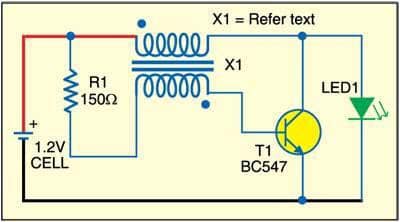The Joule Thief circuit is a basic electronic circuit that can be utilized to support a low-voltage source, like a solitary AA battery or a solar cell, to a higher voltage. It was first presented by Z. Kaparnik in 1999, and it is named after the way that it would be able “take” the energy from an almost drained battery to continue to power a circuit.
The circuit works by utilizing a transformer to move forward the voltage from the input source and afterward switch the current on and off quickly through a transistor. This makes energy be put away in the transformer’s attractive field, which is then delivered as a higher voltage when the transistor switches off. This makes a criticism circle that allows the circuit to keep working in any event, when the input voltage is lower than the expected output voltage.
To fabricate a Joule Thief circuit that can support a 1.2V source to 3V, you will require a couple of essential components including a transistor, a ferrite center transformer, a diode, a capacitor, and a couple of resistors. Here are the moves toward assembling the circuit:
Begin by winding the transformer. You can utilize a little ferrite center, like one from an old radio, and wind around 10 turns of wire around the center. This will be the essential breeze.
Then, wind around 30-40 turns of wire around the essential winding. This will be an optional breeze.
Patch the transistor to the board, and associate the essential twisting of the transformer to the gatherer of the transistor.
Associate the positive lead of the 1.2V source to the positive lead of the capacitor, and interface the adverse lead of the capacitor to the producer of the transistor.
Associate the auxiliary twisting of the transformer to the anode of the diode, and interface the cathode of the diode to the positive lead of the output.
Finally, add a resistor to limit the current and stabilize the circuit. You can connect a 1k resistor between the base of the transistor and the positive lead of the 1.2V source, and a 10k resistor between the base and the emitter of the transistor.

Whenever you have collected the circuit, you can test it by interfacing a voltmeter with the output leads. At the point when you turn on the circuit, the voltmeter ought to peruse a voltage near 3V. You can likewise test the circuit by interfacing a load, like a Drove, to the output and seeing whether it illuminates.
Advantages:
- efficiency: The Joule Thief circuit is designed to remove the most extreme measure of energy from a low-voltage source, making it a proficient method for powering little electronic gadgets.
2. Low Voltage Activity: The circuit can work on extremely low voltages, as low as 0.3V now and again, which makes it useful for applications where customary circuits wouldn’t work.
3. Practical: The Joule Thief circuit can be worked with a couple of reasonable components, making it a financially savvy answer for powering little electronic gadgets.
4. Small size: The circuit is little and can be effortlessly coordinated into smaller electronic gadgets where space is restricted.
Disadvantage:
- Voltage is unstable: The output voltage of the circuit can be unsteady and may differ relying on the input voltage, load current, and component resilience.
2. Restricted power output: The Joule Thief circuit isn’t reasonable for applications that require high power output, as it can give a couple of milliwatts of power.
3. Complexity: The circuit can be complex to design and investigate, especially for amateurs who are curious about the standards of electronics.
4. Noise and impedance: The switching activity of the circuit can create noise and electromagnetic obstruction that can influence close electronic gadgets.
Generally, the Joule Thief circuit is a useful and productive circuit for supporting low-voltage sources to power little electronic gadgets. Nonetheless, it has impediments and downsides that should be thought about while designing and utilizing the circuit.
By and large, the Joule Thief circuit is a useful and flexible circuit that can be utilized in various applications, from powering little electronic gadgets to charging batteries from solar cells. By understanding the fundamental standards of how the circuit functions and how to construct it, you can make your own Joule Thief circuits to suit your particular requirements.